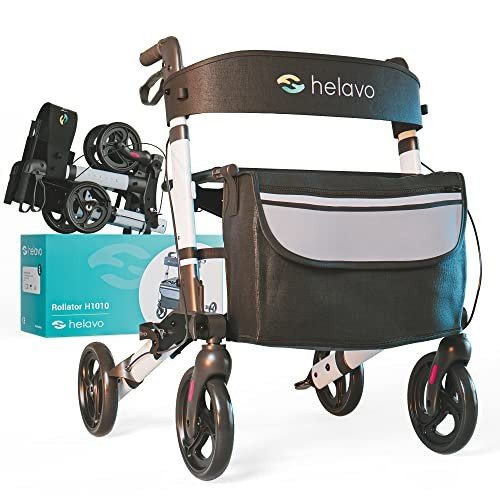Understanding Adjustable Walkers: A Comprehensive Guide
Adjustable walkers are important mobility aids designed to supply stability and support to individuals with mobility difficulties. They boost independence, safety, and self-confidence for people recovering from surgical treatment, handling persistent conditions, or facing age-related mobility concerns. This article explores the functions, types, benefits, and common FAQs connected to adjustable walkers, offering insights Rollator For Walking prospective users and caretakers.
What is an Adjustable Walker?
An Adjustable Walker (www.mymobilityscooters.uk) is a mobility aid that normally features a Lightweight Tri Walker Rollator: Easy Mobility & Comfort frame with 4 legs, equipped with handgrips for assistance. It can be changed to accommodate different heights, ensuring users attain a comfortable wrist position while supporting their weight. Adjustable walkers can be found in numerous styles, each customized to specific requirements.
Secret Features of Adjustable Walkers
- Height Adjustment: Most adjustable walkers have telescoping legs, enabling users to easily customize the height to match their stature.
- Weight Capacity: Different designs accommodate varying weight limitations, accommodating a broad demographic.
- Foldability: Many walkers are collapsible, making them easy to store and transportation.
- Wheels vs. No Wheels: Some walkers include wheels on the front legs, while others have a fundamental design without wheels, promoting stability.
- Additional Accessories: Walkers can frequently be geared up with trays, baskets, or cup holders for added benefit.
| Feature | Description |
|---|---|
| Height Adjustment | Telescoping legs for personalized height settings |
| Weight Capacity | Differs by design, supporting various body weights |
| Foldability | Collapsible style for easy transport and storage |
| Wheels | Available in both wheeled and non-wheeled choices |
| Additional Accessories | Trays, baskets, and cup holders for user benefit |
Types of Adjustable Walkers
- Standard Walkers: Traditional designs with four legs. Best for those seeking maximum stability.
- Wheeled Walkers (Rollators): Walkers with 2 or more wheels, www.mymobilityscooters.uk enabling easier maneuvering.
- Hemi Walkers: Designed for people with using one hand, featuring a single arm support for included stability.
- Child Walkers: Specifically developed for infants finding out to stroll, promoting safety and support during early mobility.
Benefits of Using Adjustable Walkers
Boost Independence
- Enhanced Mobility: Adjustable walkers allow users to browse their environments with more ease and confidence, promoting a sense of independence.
- Ease of access: With the ideal walker, users can preserve their lifestyle and engage in activities they delight in without support.
Injury Prevention
- Stability and Support: Walker users can keep better balance and avoid falls, which are especially essential for seniors and individuals recuperating from surgical treatment.
- Decreased Strain: Proper use of a walker can relieve tension on joints and muscles, lessening the threat of injury during mobility.
Convenience and Customization
- Adjustable Settings: Walkers can be tailored to each user's height and convenience, providing a more individualized experience.
- Extra Features: Options for devices help in accommodating individual needs, allowing users to carry products while moving.
Costs and Considerations
The price of adjustable walkers varies depending on features, products, and brand. Here's a summary of the average costs related to various types:
| Walker Type | Typical Cost |
|---|---|
| Standard Walkers | ₤ 50 - ₤ 100 |
| Wheeled Walkers | ₤ 75 Uplivin Trive Lightweight 4-Wheel Rollator - Red ₤ 200 |
| Hemi Walkers | ₤ 60 - ₤ 150 |
| Infant Walkers | ₤ 30 - ₤ 70 |
Often Asked Questions (FAQs)
1. How do I understand which adjustable walker is best for me?
The ideal adjustable walker depends upon your particular requirements, physical condition, and environment. It's necessary to consult a healthcare expert to figure out the most appropriate type.
2. Can I change the height of any walker?
A lot of adjustable walkers include a height-adjustment mechanism. Nevertheless, not all walkers are adjustable. It's important to analyze item specs before buying.
3. Are wheeled walkers safe to use?
Yes, wheeled walkers (or rollators) are safe for users who can browse them appropriately. They typically consist of brakes for included safety when stationary.
4. How do I take care of my adjustable walker?
Routine care includes cleaning the walker with mild soap and water, looking for wear on grips and wheels, and guaranteeing mechanisms run efficiently.
5. Can I take my adjustable walker on public transportation?
Yes, numerous adjustable walkers are foldable and created for easy transport. Nevertheless, it's recommended to examine the particular standards of the transport service.

6. Do I need help to use an adjustable walker?
Lots of users can operate adjustable walkers separately, specifically when appropriately fitted to their height. Nevertheless, those with severe mobility problems might gain from help.
Adjustable walkers are invaluable tools for improving mobility, independence, and safety. With a range of designs and styles, individuals can discover a walker tailored to their requirements. Caretakers and users alike should appreciate the importance of speaking with health care experts to make informed decisions relating to mobility aids. Comprehending the functions, benefits, and considerations of adjustable walkers empowers people to keep an active lifestyle, enriching their lifestyle in spite of mobility challenges.
